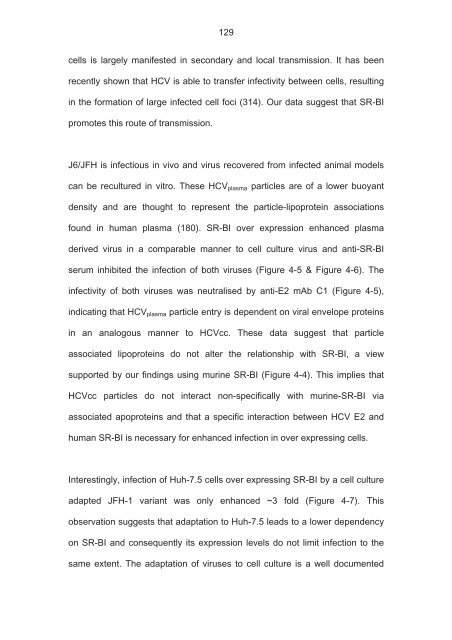The role of scavenger receptor BI in hepatitis - eTheses Repository ...
The role of scavenger receptor BI in hepatitis - eTheses Repository ...
The role of scavenger receptor BI in hepatitis - eTheses Repository ...
Create successful ePaper yourself
Turn your PDF publications into a flip-book with our unique Google optimized e-Paper software.
129<br />
cells is largely manifested <strong>in</strong> secondary and local transmission. It has been<br />
recently shown that HCV is able to transfer <strong>in</strong>fectivity between cells, result<strong>in</strong>g<br />
<strong>in</strong> the formation <strong>of</strong> large <strong>in</strong>fected cell foci (314). Our data suggest that SR-<strong>BI</strong><br />
promotes this route <strong>of</strong> transmission.<br />
J6/JFH is <strong>in</strong>fectious <strong>in</strong> vivo and virus recovered from <strong>in</strong>fected animal models<br />
can be recultured <strong>in</strong> vitro. <strong>The</strong>se HCVplasma particles are <strong>of</strong> a lower buoyant<br />
density and are thought to represent the particle-lipoprote<strong>in</strong> associations<br />
found <strong>in</strong> human plasma (180). SR-<strong>BI</strong> over expression enhanced plasma<br />
derived virus <strong>in</strong> a comparable manner to cell culture virus and anti-SR-<strong>BI</strong><br />
serum <strong>in</strong>hibited the <strong>in</strong>fection <strong>of</strong> both viruses (Figure 4-5 & Figure 4-6). <strong>The</strong><br />
<strong>in</strong>fectivity <strong>of</strong> both viruses was neutralised by anti-E2 mAb C1 (Figure 4-5),<br />
<strong>in</strong>dicat<strong>in</strong>g that HCVplasma particle entry is dependent on viral envelope prote<strong>in</strong>s<br />
<strong>in</strong> an analogous manner to HCVcc. <strong>The</strong>se data suggest that particle<br />
associated lipoprote<strong>in</strong>s do not alter the relationship with SR-<strong>BI</strong>, a view<br />
supported by our f<strong>in</strong>d<strong>in</strong>gs us<strong>in</strong>g mur<strong>in</strong>e SR-<strong>BI</strong> (Figure 4-4). This implies that<br />
HCVcc particles do not <strong>in</strong>teract non-specifically with mur<strong>in</strong>e-SR-<strong>BI</strong> via<br />
associated apoprote<strong>in</strong>s and that a specific <strong>in</strong>teraction between HCV E2 and<br />
human SR-<strong>BI</strong> is necessary for enhanced <strong>in</strong>fection <strong>in</strong> over express<strong>in</strong>g cells.<br />
Interest<strong>in</strong>gly, <strong>in</strong>fection <strong>of</strong> Huh-7.5 cells over express<strong>in</strong>g SR-<strong>BI</strong> by a cell culture<br />
adapted JFH-1 variant was only enhanced ~3 fold (Figure 4-7). This<br />
observation suggests that adaptation to Huh-7.5 leads to a lower dependency<br />
on SR-<strong>BI</strong> and consequently its expression levels do not limit <strong>in</strong>fection to the<br />
same extent. <strong>The</strong> adaptation <strong>of</strong> viruses to cell culture is a well documented

















